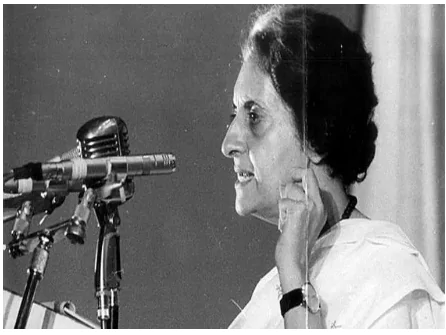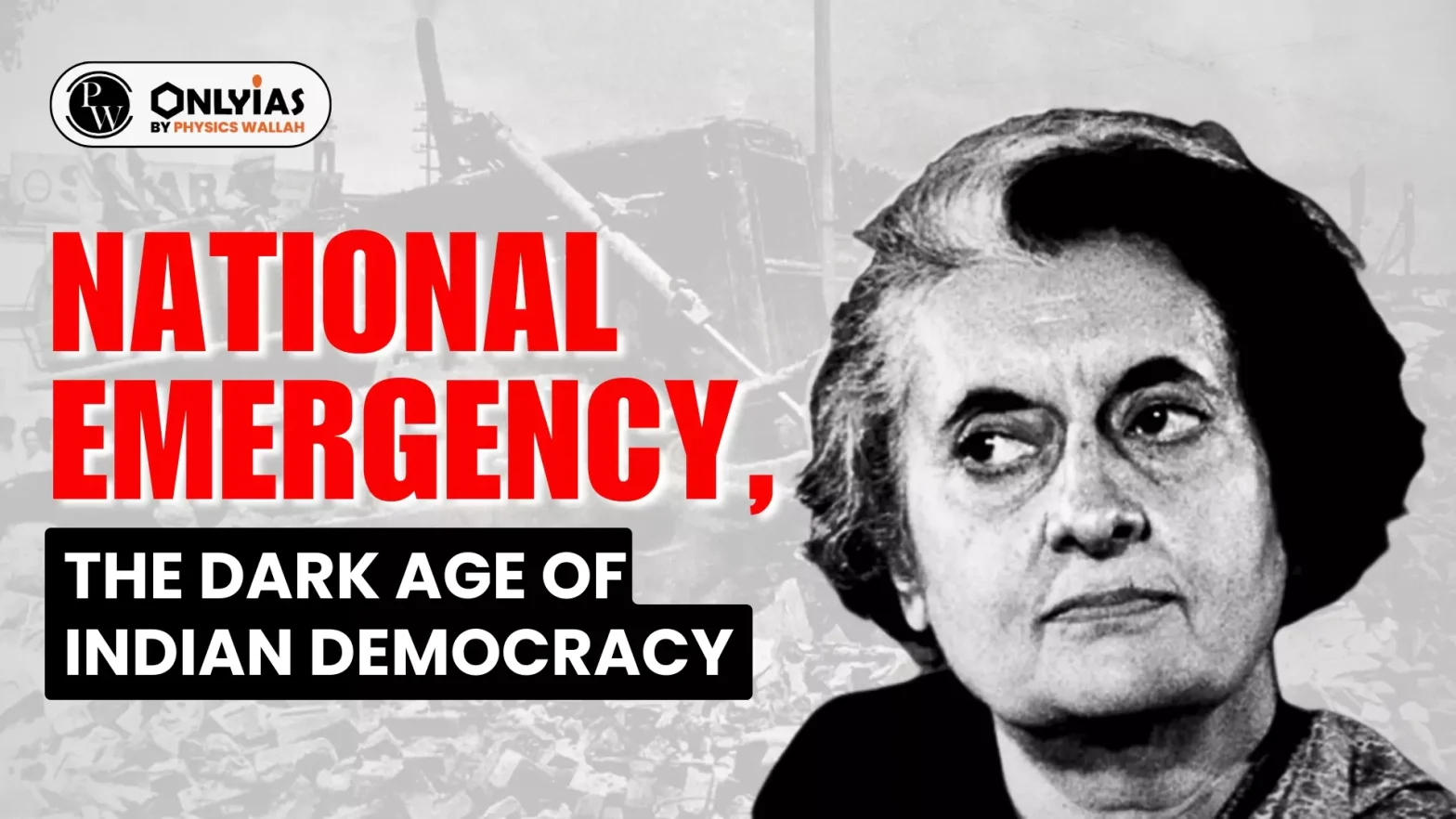This year marks the 50th anniversary of the Emergency, which is considered as one of the most controversial periods in India’s political history.
Emergency

- Definition: In the purview of political systems Emergency provisions are those special prerogatives that a government or a president can resort to in extraordinary situations such as war, insurgency, terrorist attacks, or other severe threats to the state, environmental calamities, serious industrial accidents, pandemics or similar situations that threaten a great number of lives.
- Types of Emergencies in the Indian Constitution: The Constitution stipulates three types of emergencies-
- National Emergency: National emergency can be declared on the basis of war, external aggression or armed rebellion.
- Constitutional Emergency/President’s Rule: If any state fails to comply with the direction of the centre or there is any failure of constitutional machinery, President rule can be imposed on the such state.
- However, the Constitution does not use the word ‘emergency’ for this situation.
- Financial Emergency: Article 360 empowers the president to proclaim a Financial Emergency if he is satisfied that a situation has arisen due to which the financial stability or credit of India or any part of its territory is threatened.
- Components of Emergency:
- Curtailment of Fundamental Rights: Fundamental rights, including the freedom of speech and expression guaranteed under Article 19(1)(a), were curtailed, which led to pre-censorship of the press.
- Suspension of civil liberties.
- Curtailment of press freedom.
- Mass arrests, the cancellation of elections, and rule by decree.
Enroll now for UPSC Online Course
Difference between Martial Law and Emergency in India:
- Martial Law is imposed when civilian authorities lose control and military authorities take over governance. It typically involves the suspension of ordinary law, and military courts may replace civilian courts.
- There is no specific provision for martial law in the Indian Constitution.
- It is a de facto situation resulting from a breakdown of law and order.
- The imposition of Martial Law can lead to the suspension of all civil rights and freedoms, with military authority overriding civilian control.
- Emergency is declared under specific constitutional provisions (Articles 352, 356, and 360) in response to war, external aggression, armed rebellion, or financial crises, allowing the central government to assume increased powers.
- The provisions of Emergency are clearly defined in the Constitution with procedural safeguards and requirements .
- Certain fundamental rights (such as Article 19) may be suspended during Emergency, but the Constitution and civilian government remain in force.
|
- Implications of the Imposition of National Emergency:
- Federal Structure Transformation: The declaration of Emergency converts the federal structure into a de facto unitary one.
- Central Control Over State Governments: During this period, the Union acquires the right to give any directions to state governments, bringing them under complete control of the Centre without suspending them.
- Extension of Lok Sabha Term: Parliament can extend the five-year term of the Lok Sabha by one year at a time.
- Legislative Powers on State Subjects: Parliament can make laws on subjects in the State List.
- Expansion of Union’s Executive Powers: Parliament can extend the Union’s executive powers to the states and make laws on subjects in the State List.
- Modification of Financial Provisions: The President, with parliamentary approval, can modify constitutional provisions regarding the allocation of financial resources between the Union and the states.
- Legal and Constitutional sanction behind the imposition of National Emergency:
- Article 352 Provisions
- Under Article 352 of the Constitution, the President may issue a proclamation of emergency on the advice of the Council of Ministers headed by the Prime Minister.
- An emergency can be declared if the security of India or any part of the country is threatened by “war, external aggression, or armed rebellion.”
- Basis for 1975 Emergency Declaration
- In 1975, the government used the ground of “internal disturbance” to proclaim an emergency instead of armed rebellion.
- The government’s press note indicated that certain individuals were inciting the police and armed forces to not discharge their duties.
- This was an apparent reference to Jayaprakash Narayan’s call to the police not to follow orders that were deemed “immoral.”
- Unique Instance of Emergency Due to “Internal Disturbance”
- The proclamation of emergency in 1975 was the only instance where it was declared due to “internal disturbance.”
- Earlier proclamations of emergency: The 1962 emergency during the Indo-China war, and the 1971 emergency during the Indo-Pakistan war.
- Both instances were declared on grounds of war.
Revocation of Proclamation Of National Emergency
- Revoked by the President: A proclamation of emergency may be revoked by the President at any time by a subsequent proclamation.
- Such a proclamation does not require parliamentary approval.
- Lok Sabha passes resolution: Further, the President must revoke a proclamation if the Lok Sabha passes a resolution disapproving its continuation. This safeguard was introduced by the 44th Amendment Act of 1978.
- 44th Amendment Act of 1978: Where one-tenth of the total number of members of the Lok Sabha give a written notice to the Speaker (or to the president if the House is not in session), a special sitting of the House should be held within 14 days for the purpose of considering a resolution disapproving the continuation of the proclamation.
- Requirements: A resolution of disapproval is required to be passed by the Lok Sabha only and is to be adopted by a simple majority only.
Emergency in India
- About: The Emergency in India refers to a 21-month period from 1975 to 1977 during which Prime Minister Indira Gandhi used special provisions in the Constitution to declare a state of emergency across the nation, citing internal threats to the country.
- Declared by: Officially declared by President Fakhruddin Ali Ahmed under Article 352 of the Indian Constitution due to prevailing “internal disturbance”.
- Effect from: The Emergency was in effect from June 25, 1975, to March 21, 1977.
Check Out UPSC CSE Books From PW Store
Legal Changes during the National Emergency Period
- Parliamentary Legislation:
- Constitution (Thirty-eighth Amendment) Act: Passed by Parliament, it prohibited judicial review of the Emergency, limiting the judiciary’s oversight powers.
- Constitution (Thirty-ninth Amendment) Act: Enacted to shield the election of the Prime Minister from Supreme Court challenges, consolidating executive authority.
- Constitution (Forty-second Amendment) Act: Introduced extensive amendment.
- Removed the judiciary’s jurisdiction over election petitions.
- Expanded Union authority over State subjects, centralising governance.
- Granted Parliament unrestricted power to amend the Constitution without judicial review.
- Protected laws implementing directive principles of state policy from judicial scrutiny.
- ADM Jabalpur vs Shivkant Shukla, 1976:
- Detention without Trial was made legal: In a landmark case, the Supreme Court ruled, in a five-judge Bench decision, that detention without trial was legal during the Emergency.
- Justice H R Khanna was the sole dissenter, opposing the majority’s verdict and upholding civil liberties.
Efforts made by government to undo the damage caused by the National Emergency
- 42nd Amendment Act Repeal: The Janata government reversed several provisions of the controversial 42nd Amendment Act of 1976.
- Emergency Provisions: It did not do away with the provision of the emergency, but made it extremely difficult to impose for the future.
- Removal of “Internal Disturbance” Ground: The Constitution (Forty-fourth Amendment) Act, 1978, enacted by the Janata government post-Emergency, removed the provision allowing proclamation of emergency on grounds of “internal disturbance.” Meaning that armed rebellion alone would now be a ground, apart from war and external aggression.
-
- However, the 44th Amendment left the words ‘secular’ and ‘socialist’, inserted in the Preamble by the 42nd Amendment, untouched.
- Restoration of Judicial Review: Judicial review of a proclamation of emergency was reinstated, restoring the judiciary’s oversight role.
- Parliamentary Accountability:
- It was mandated that every proclamation of emergency should be laid before both Houses of Parliament within a month of the proclamation.
- Unless it was approved by both Houses by a special majority — a majority of the total strength of the House and not less than two-thirds of the members present and voting — the proclamation would lapse.
- Shah Commision:
- Aim: The Shah Commission was constituted by the Janata government to report on the imposition of the Emergency and its adverse effects.
- Findings: The Commission submitted a report highlighting that the decisions taken to impose Emergency were unilateral, and adversely affected civil liberties.
Enroll now for UPSC Online Classes
Conclusion
The National Emergency serves as a cautionary tale in Indian democratic politics, emphasising the importance of institutional checks, civil liberties, and public accountability.
- Even today, references to the Emergency continue to shape political discourse and perceptions of governmental actions, highlighting enduring concerns over democratic principles and governance practices in India.
![]() 29 Jun 2024
29 Jun 2024


